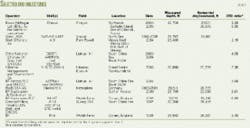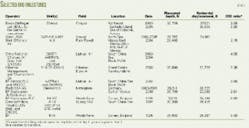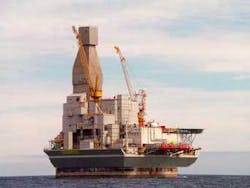New extended-reach drilling projects are driving the development of innovative technologies and changing operating practices.
BP PLC is funding the design of a new land rig that can drill to 40,000 ft on the North Slope and Statoil ASA is planning to overhaul three platforms and begin extended-reach drilling at Gullfaks in 2007. Royal Dutch/Shell will also drill an extended-reach development well in the UK sector of the North Sea from one of its existing platforms.
Technology-savvy operators have used extended-reach drilling around the world, beginning with BP’s successful Wytch Farm wells in 1995 (Table 1). Other European ERD projects include: RWE-DEA AG’s wells from the Mittelplatte rig in northern Germany; Maersk Olie og Gas AS in the Dan field off Denmark; Statoil in the Sleipner field and Norsk Hydro AS in the Oseberg field off Norway.
In Asia, ERD successes have attracted enough attention to warrant a separate conference, in Kuala Lumpur in November 2005:
- Frank de Lange and Jack Pearse, engineers from Shell Todd Oil Services (STOS) discussed risks and best practices drilling New Zealand’s longest wells at the Pohokura field, off the North Taranaki coast.
- Magne Heggoe, drilling superintendent for ConocoPhillips China, presented best practices for ERD in the Xijiang field in the South China Sea. ConocoPhillips has set records in the Xijiang 24-3 field, and the successes are particularly notable because some were drilled before rotary steerable technology was commercially available.
- Tang Hai Xiong, drilling department manager, and Wei Hong An, technology supervisor for China National Offshore Oil Corp. Ltd., explained how ERD extended the life of CNOOC’s Lihua field in the South China Sea (OGJ, Aug. 1, 2005, p. 35).
- Yap Yun Thiam, drilling engineer for Petronas Carigali Sdn. Bhd., reviewed the planning and execution of the Angsi A-28ST1 well, Malaysia’s longest well.
Woodside Energy Ltd. has used ERD to develop the Goodwyn field in Australia. The company switched from invert-emulsion drilling muds to ester-based drilling muds for its extended-reach wells a few years ago because they provided better lubrication to reduce torque and drag.
ERD is not widespread in South America, although Total, as operator of the Consortium Cuenca Marina Austral, drilled very long ERD wells in the Ara and Kaus fields off Tierra del Fuego in Argentina. In 1997-98, Total drilled six extended-reach wells from the Alfa Sur onshore base into the Ara West field, 6-10 km offshore. Halliburton assisted in the Cullen Norte well, drilled in 1999, with a 34,850-ft horizontal displacement.
Challenges
Operators choose ERD to reduce the environmental impact and costs of installing additional platforms or building artificial gravel islands.
But extended or extreme-reach wells must be designed to overcome the drag and friction on drill pipe and casing posed by long, horizontal sections.
Drilling rigs must have the power and hook-load capacity to handle the weight of long drill strings and a robust hydraulic system with sufficient pump capacity to provide and process large fluid volumes. Rigs drilling record-length wells often have four, 1,600-hp pumps.
Longer drilling times in ERD mean that the borehole is exposed for a longer time, leading to potential hole instability. Drilling equipment and operating procedures should be modified to reduce drilling and openhole time.
Increasing rig efficiency with automated systems and the ability to take repetitive jobs out of the critical path will increase drilling speed and reduce overall rig time, making these wells even more cost-effective.
North Sea
Shell plans a single ERD well for the Barnacle field in UK Block 211/29 of the North Sea, drilling from the Brent Delta platform, Offshore247.com reported in August. The Barnacle field was discovered in 1992 with the 211/29-10 well and lies 4.75 km (about 3 miles) northeast of the Brent Delta platform.
Energy Development Partners will operate the block for Shell and spud the ERD well in November. EDP plans to drill the well “as a sidetrack of the existing BD 46 well, which is currently suspended and will be abandoned by Shell” prior to beginning the Barnacle sidetrack. EDP expects about 80 days of drilling, with first production anticipated in January 2007.
In 2004-05, Statoil ASA drilled a record length extended-reach well in the Visund field from a floating production and drilling platform in the Tampen area of the Norwegian North Sea. Odfjell Drilling AS drilled the 3 4/8-A-6 AHT2 well to a measured depth of 9,082 m (29,797 ft) with a horizontal displacement of 7,593 m (Table 1).1
The A-6 well was 819 m deeper than the previous longest reach extended-reach well, the A-22, which was drilled in the same field in 2003. The A-6 well used a full length, intermediate sized 5 7/8/-in. drill string, rather than the conventional tapered drill string incorporating several pipe sizes that was used in the A-22 well.2
Advantages of using the monobore string include: quicker running and handling speed; smaller handling tool inventory and less maintenance; reduced surface pump pressure and maintenance; lower drill string weight; and a large cost savings from the increased drilling speed.2
Statoil’s Visund team envisions drilling 12-14 km wells from Visund into the furthest extremities of the field.
Statoil also plans to use extended reach drilling at another northern North Sea field-Gullfaks. At the recent Offshore Northern Seas (ONS) conference in Stavanger in August, Statoil’s Lars Christian Bacher said the company plans to use ERD at Gullfaks.
Statoil will modify three platforms and begin a 20-year exploration and development program with four extended-reach exploration wells in 2007. The wells are on the periphery of the Gullfaks area, near the Epidot and Alun discoveries.
Statoil, Halliburton Corp., and Prosafe Offshore Ltd. have already been successful using underbalanced techniques to improve drilling performance from the Gullfaks C platform in summer 2004.
Bacher said Statoil expects the ERD program to increase Gullfaks oil recovery to 69%.
Sakhalin
Exxon Neftegas Ltd. (ENL) operates for the Sakhalin-1 consortium, which is developing three fields: Chayvo, Odoptu, and Arkutun-Dagi, with total anticipated recovery of 2.3 billion bbl of oil and 17.1 trillion cu. ft of natural gas.3
The Chayvo field development plan includes 10-15 onshore extended reach drilling wells with reaches of 8-10 km, drilled from land into the Sea of Okhotsk, and about 18 offshore directional wells drilled from an ice-resistant platform.
Chayvo onshore ERD operations began in July 2003 and 10 of the planned land-based ERD wells were drilled by mid-2005 with the Yastreb drilling rig (OGJ Online, July 13, 2005). Additional Chayvo wells are being drilled from the Orlan concrete island in about 15 m water depth (Fig. 1).
The Chayvo wells had ERD ratios of nearly 4, with a maximum length of 33,406 ft, and horizontal displacement of 30,335 ft (Table 1).
Engineers from ExxonMobil Development Co. believe that the next generation of ERD at Sakhalin will benefit from improvements discerned from Chayvo drilling.4 These include:
- Using redesigned completions, with stand-alone screens (SAS), predrilled liners, and well packers.
- Running improved rotary steerable systems that measure and manage vibration.
- Using drill bits designed to minimize overall overall drill string torque.
- Running conventional mud-filled casing.
The built-for-purpose Yastreb rig was designed by Houston-based Parker Drilling Co. to support extended-reach drilling and resist earthquake tremors (OGJ, June 17, 2002, p. 41). Skid rails are attached to driven pilings and the drilling module is clamped to the rails. The rig also features a compliant mast design. It has a fully enclosed and insulated pipe barn and derrick, a high-torque top drive, four 1,600-hp mud pumps, and high-capacity shale shakers.
Liberty then
The Liberty project in the Beaufort Sea is getting a fresh look. BP Exploration Alaska Inc. (BPXA), a division of BP PLC, drilled the Liberty discovery well in Federal waters on the outer continental shelf in February-March 1997. BPXA used the Pool Arctic Alaska (PAA) No. 4 rig to drill from the Tern gravel and ice island in 21 ft water, about 20 miles east of Prudhoe Bay.
Liberty No. 1 was the second to last well drilled in the Beaufort Sea. The last well was Warthog, drilled by Arco Alaska Inc. in November-December 1997, with the Glomar Beaufort Sea No. 1 rig in 35 ft water.
BP initially attempted to develop Liberty from an artificial gravel island, submitting and revising development and production plans beginning in 1998.
In January 2002, BP announced that it was putting the Liberty project development on hold, and in March 2002, it notified the MMS and other agencies that they should suspend processing of applications, pending revisions. In May 2002, the US Minerals Management Service issued the final environmental impact statement for the Liberty project, based on BP’s initial plans. BP had proposed three alternatives: building Liberty Island about 5 miles offshore; using the existing Tern Island; or building Southern Island.
Liberty now
Now BP is evaluating extended-reach drilling in the Liberty field from a shore-based drilling site (OGJ, Nov. 7, 2005, p. 8).
Extended-reach wells planned from a Liberty land site would greatly expand the BP “drilling envelope” with equivalent departures beyond 40,000 ft and total vertical depth of about 11,500 ft.
BP’s record-length departure is currently the M-16Z well in the Wytch Farm field, drilled to 37,001 ft MD with a horizontal displacement of 35,196 ft in 1999 (Table 1). The well had an ERD ratio (measured depth to vertical depth) of 6.89; the highest ERD well drilled to date, worldwide. (Recent Chayvo wells approach the two longest Wytch field wells in length, but the Chayvo wells are deeper, nearly 8,000 TVD.)
In early August, Parker Drilling announced that it was selected by BP to design a new drilling rig for the Liberty project. One design requirement is that the rig must be able to drill wells out to 8.3 miles (43,824 ft), a distance not yet attempted. “If the rig is built,” Parker says, it will be the “largest in the world and drill the longest wells in the world.”
References
1. Hjelle, Arne, Teige, T.G., Rolfsen, K., Hanken, K.J., Hernes, S., and Huelvan, Y., “World-Record ERD Well Drilled From a Floating Installation in the North Sea,” paper SPE 98945, presented at the 2006 IADC/SPE Drilling Conference, Miami, Feb. 21-23, 2006.
2. Ogilvie, W., Chandler, R.B., Devlin, A., Kile, H., Rolfsen, K., and Eilertsen, Ø, “Achieving Statoil Visund’s World Record Reach With Intermediate-Size Drillpipe-A Case History,” paper 99172-MS, presented at the 2006 IADC/SPE Drilling Conference, Miami, Feb. 21-23, 2006.
3. “A hawk lands at Chayvo,” Exxon magazine, The Lamp, Vol. 86, No. 1, 2004.
4. Viktorin, R.A., McDermott, J.R., Rush, R.E., and Schamp, J.H., “The Next Generation of Sakhalin Extended-Reach Drilling,” paper 99131-MS, presented at the IADC/SPE Drilling Conference, Miami, Feb. 21-23, 2006.


